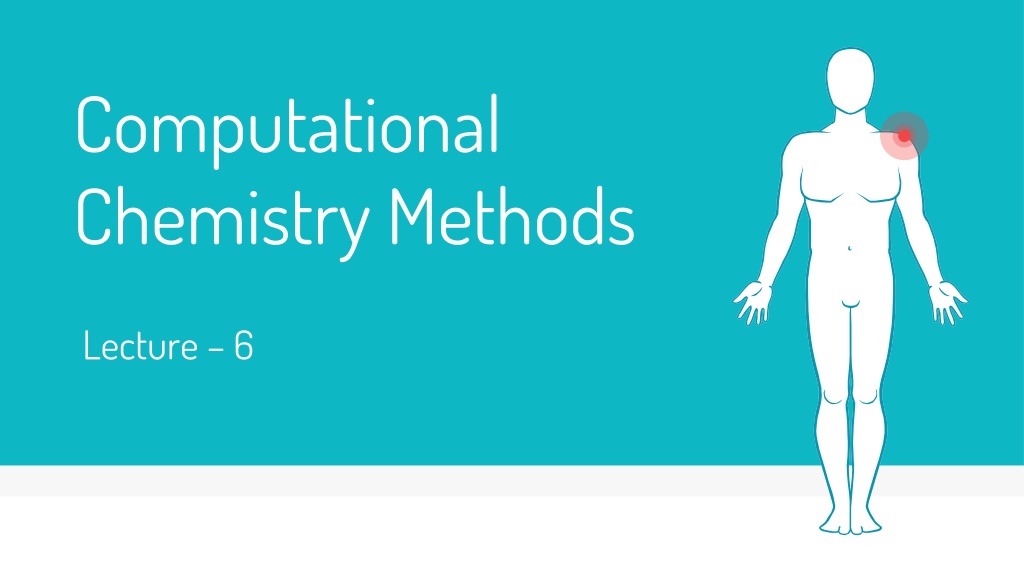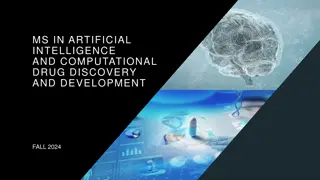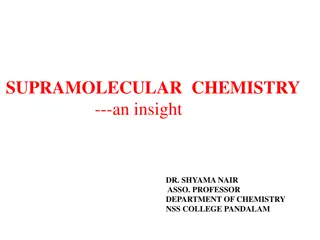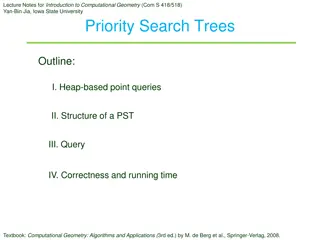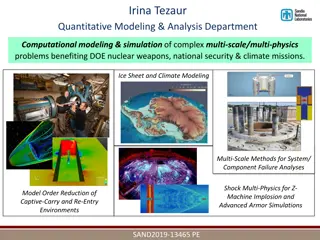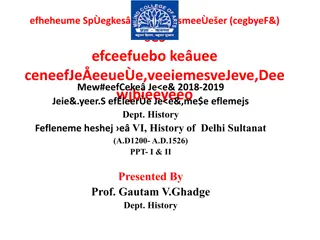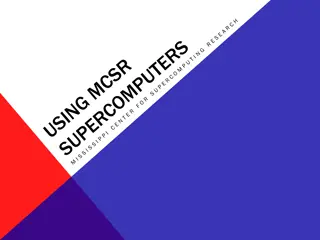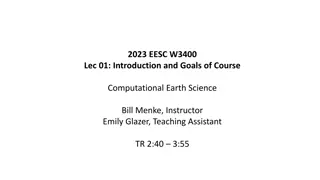Computational Chemistry Methods
The field of computational chemistry focuses on simulating chemical systems to provide detailed information at an atomic level. This involves two main methodological families: quantum chemical methods and molecular mechanics. Quantum chemistry methods explicitly consider electrons, while molecular mechanics hide their presence in force fields. Techniques such as ab initio, density functional, and semi-empirical methods play crucial roles in solving chemical problems. Classical methods use Newtonian mechanics, while quantum chemistry methods utilize quantum mechanics to model molecular systems, employing approximations to solve the Schrödinger's Equation. Molecular mechanics programs calculate force fields using classical physics equations, treating atoms as spheres and bonds as springs, while electron interactions are ignored.
Download Presentation

Please find below an Image/Link to download the presentation.
The content on the website is provided AS IS for your information and personal use only. It may not be sold, licensed, or shared on other websites without obtaining consent from the author.If you encounter any issues during the download, it is possible that the publisher has removed the file from their server.
You are allowed to download the files provided on this website for personal or commercial use, subject to the condition that they are used lawfully. All files are the property of their respective owners.
The content on the website is provided AS IS for your information and personal use only. It may not be sold, licensed, or shared on other websites without obtaining consent from the author.
E N D
Presentation Transcript
Computational Chemistry Methods Lecture 6
CONTENTS Computational Chemistry Methods 1. Ab Initio Methods 2. Density Functional Methods 3. Semi-empirical Methods
Definition The main objective of computational chemistry is to solve chemical problems by simulating chemical systems (molecular, biological, materials) in order to provide reliable, accurate and comprehensive information at an atomic level. To this end, there are two main methodological families: those based on quantum chemical methods and those based on molecular mechanics. The former are methods in which the electrons are explicitly accounted for, while in the latter their presence is hidden in the force field.
Computational Chemistry Methods 1. Classical Methods 2. Quantum chemistry method
Classical Methods Are those method use Newton mechanics to model molecular system. Quantum chemistry method:- Which makes use of Quantum mechanics to model the molecular system. This method used different type of approximation to solve Schr dinger s Equation. 1. Molecular Mechanics 2. Molecular Dynamics Quantum chemistry method:- Which makes use of Quantum mechanics to model the molecular system. This method used different type of approximation to solve Schr dinger s Equation. Quantum Mechanics Methods 1. Semi empirical Methods. 2. Ab initio Methods. 3. Density functional Theory.
Molecular Mechanics Molecular Mechanics Molecular mechanics programs use equations based on classical physics to calculate force fields. Atoms treated as spheres, bonds as springs and electron are ignored. It assume that the total potential energy (Etotal) of molecule is given by sum of all the energies of attractive and repulsive forces between atom in structure The molecular mechanics equation E = EB+EA+ED+ENB* *EB = The energy involved in the deformation bond either by stretching or compression. EA = The energy involved in the angle bending . ED = The torsional angle energy. ENB = The energy involved in the interaction between atoms that are not directly bonded.
Force Field Force field refers to calculation of the interaction and energies between different atoms between bond stretching, angle bending
Molecular Dynamics Molecular dynamics is a molecular mechanics program designed to mimic the movement of atoms within a molecule. Molecular dynamics can be carried out o a molecule to generate different conformation which on energy minimization, give a range of stable conformation. Alternatively bonds can be rotated in a stepwise process to generate different conformation
Quantum mechanics Quantum mechanics is based on arrangement of electrons of molecule and interaction of those electron with electron and nuclei of other molecule. It based on the realization that electron and all material exhibit wavelike properties. The Quantum mechanics based on finding solution to Schr dinger wave equation.
Schrdingers Equation The Schr dinger equation is the basis of quantum mechanics and gives a complete description of the electronic structure of a molecule. H = E Where H=Hamiltonian operator =wave fuction E =Energy system
Ab Initio method Ab initio translated from Latin means from first principles . This refers to the fact that no experimental data is used and computations are based on quantum mechanics. It derived directly from theoretical principle
Different Levels of Ab Initio Calculations 1. 2. Hartree-Fock (HF) Density Functional Theory (DFT) Hartree-Fock (HF) The simplest ab initio calculation. It based on Central field approximation (The central field approximation is developed as a basis for describing the interaction of electrons with the nucleus, and with each other, using perturbation theory). The major disadvantage of HF calculations is that electron correlation is not taken into consideration. Density Functional Theory Considered an ab initio method, but different from other ab initio methods because the wave function is not used to describe a molecule. Density functional theory in which total energy is expressed in term of total electron density is used. DFT methods take less computational time than HF calculations and are considered more accurate. NB: Electronic correlation is the interaction between electrons in the electronic structure of a quantum system. The correlation energy is a measure of how much the movement of one electron is influenced by the presence of all other electrons.
Semi-empirical quantum methods, represents a middle road between the mostly qualitative results available from molecular mechanics and the high computationally demanding quantitative results from ab initio methods. Semi empirical methods use experimental data to parameterize equations. Like the ab initio methods, a Hamiltonian and wave function are used. Less accurate than ab initio methods but also much faster.
Choice of Method The method of calculation based on what calculation needs to done and size of molecule. Molecular mechanics useful for Energy minimization Identifying stable conformation Energy calculation for specific conformations Studying molecular motion Studying different conformation.
